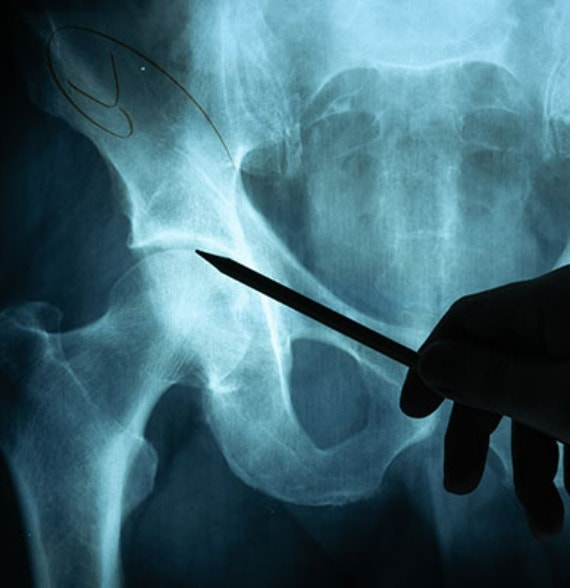Schedule An Appointment With Us
Have You Sustained A Hip Injury Recently?
Consult our MOH-accredited hip dislocation specialist for a personalised treatment plan.
Hip dislocations typically occur as a result of severe trauma, such as car accidents or falls from significant heights. They happen when the head of the femur is forced out of its socket in the pelvic bone, often leading to intense pain and mobility issues.
MBBS
MRCSEd
MMED (Ortho)
FRCSEd

Hip dislocation occurs when the ball of the femoral head, located at the top of the thigh bone, is forcefully dislodged from its socket in the pelvis, known as the acetabulum. The hip, being a ball-and-socket joint, is designed for both stability and a wide range of movement, making a dislocation a severe disruption to its normal function.
The primary cause of hip dislocation is usually a traumatic injury, often requiring a large force.
Identifying the symptoms and signs of hip dislocation can help lead to timely and effective treatment.

The diagnosis of a hip dislocation involves a combination of physical examination and imaging tests.
Hip dislocation is a medical emergency requiring urgent care. Early activation of emergency medical services can help minimise long-term damage.
When a hip dislocation does not involve severe associated injuries and can be managed without surgical intervention, non-surgical treatment options are available.
This procedure is used in cases where hip dislocation is the sole injury present. Closed reduction involves manually repositioning the dislocated hip back into its socket. It typically requires anaesthetic or sedative administration to alleviate pain and relax muscles during the procedure.
It should be done as soon as possible, to reduce damage to the cartilage surfaces of the joint and to maintain functionality of the femoral head.
In cases where non-surgical methods are insufficient or when the hip dislocation is accompanied by more complex injuries, surgical intervention may be necessary.
This procedure is employed when a closed reduction is unsuccessful or if there are associated fractures. Open reduction involves surgically exposing the hip joint to properly align and secure the dislocated bones.
Particularly in cases of recurrent dislocations or in individuals with hip dysplasia, surgical procedures may be undertaken to stabilise the hip joint. This can involve the use of screws, plates, or other hardware to secure the joint.
Preventing hip dislocation involves a combination of safety measures, conditioning, and special care in certain cases.
Schedule An Appointment With Us
Consult our MOH-accredited hip dislocation specialist for a personalised treatment plan.

MBBS
MRCSEd
MMED (Ortho)
FRCSEd
With over 18 years of experience, Dr Poh Seng Yew is an orthopaedic surgeon specialising in hip, knee, shoulder and elbow surgery, sports medicine, and trauma surgery.




Weekdays: 9.00am – 5.00pm
Saturdays: 9.00am – 1.00pm
Sundays and Public Holidays: Closed
Your injury shouldn’t affect your quality of life or disrupt daily activities. Reach out to our friendly clinic staff today & schedule a consultation.
The recovery time after a hip dislocation varies, depending on the injury’s severity, the patient’s age and their overall health. Generally, a few months is the usual recovery timeline, although it may extend longer if there are additional complications such as fractures. Rehabilitation, including physical therapy, plays a role in restoring range of motion and strength to the hip joint.
Long-term consequences of a hip dislocation depend on the injury’s severity and may include nerve damage, osteonecrosis (also known as avascular necrosis), and osteoarthritis. Chronic pain, instability, mobility issues, and muscle weakness are also possible. Timely and appropriate treatment by our hip specialists can avoid these complications. Reach out to us for a personalised treatment plan.
The risk of a hip dislocation recurring is higher in individuals who have previously experienced dislocation or have conditions that increase dislocation risk, such as hip dysplasia or cerebral palsy. The longer a hip dislocation remains untreated, the more likely the joint will destabilise, increasing the risk of future injuries. Consult our hip specialist promptly for timely treatment and effective management.
After a hip dislocation, avoid activities that put undue stress on the hip joint. This includes certain movements, heavy lifting, and high-impact activities. Adhering to the rehabilitation plan and following the guidance of your hip specialist can help lead to a safe and effective recovery.
Walking with a dislocated hip is typically not possible due to the severe pain and the inability of the joint to function correctly. Immediate medical attention is necessary for proper treatment and to prevent further damage or complications. Our hip specialist is equipped to provide the necessary care and guidance for such conditions.